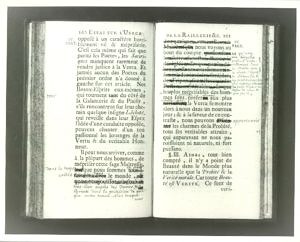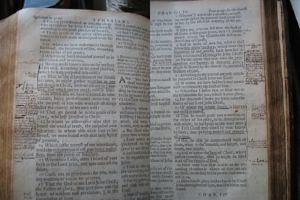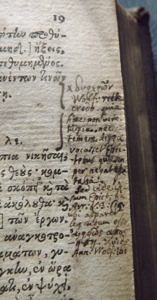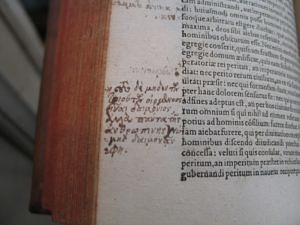Library: Watching Shaftesbury Read
Watching Shaftesbury Read
The present Earl of Shaftesbury very kindly granted us access in October 2011 and again in April 2012 to those books from the third Earl’s library which are now assembled to form a subsection of the substantial collection at St Giles’s House. This enabled us to compare the volumes there with the titles listed in Paul Crell’s catalogue. Such collation remains, however, very much a work in progress, as it is more than likely that other books once owned by the third Earl still lie “hidden” among the other tomes in the library; moreover, a small selection of “treasures” (e.g. the more heavily annotated books) are preserved separately for safe-keeping. And, of course, a substantial number of books have left the house over the centuries, for example to be sold at auction. The items on sale at Christie’s in November 1966 and February 1967 included Pierre Coste’s translation of Sensus Communis, a copy which is known to have contained evidence of Shaftesbury’s revision.
The “jewel of the collection […] annotated and corrected […] on more than 20 pages. This important little book shows Shaftesbury in the process not only of correcting the translation, but also of amending his own thoughts for the Characteristicks”; the copy is said to be “littered with pen-and-ink corrections in his careful and concise hand”, with “notes on end paste-down, all in the hand of the author”; divisions not found in first English edition were introduced here. P & C suggest that a comparison of the corrections in the French with the original English text reveals “many minor errors and misrepresentations which a less exact author might have let pass.” The purpose of the revisions is twofold: first, Shaftesbury “was probably making these notes in his copy to pass on to the publisher lest a second edition be called for”; secondly, Shaftesbury was working on “what was in effect a revision of his original text. On at least one occasion, his revision of the French was incorporated in the text published in 1711.”
 Courtesy of Pickering & Chatto
Courtesy of Pickering & Chatto
Editio princeps of Sensus Communis, 1709, p. 111:
When we are highly Friends with the World, and prosperous in the possession of other Beautys, we may perchance, as is usual, despise this sober Mistress.
Coste’s translation, Essai sur l’usage de la raillerie, 1710, pp. 160-1:
Il peut nous arriver, comme à la plûpart des hommes, de mépriser cette sage Maîtresse, lorsque nous sommes tout-à-fait bien avec le monde, & que nous jouïssons à souhait de quelque autre Beauté.
Shaftesbury’s revision:
Il peut nous arriver, comme à la plûpart des hommes, de mépriser cette sage Maîtresse, dans le temps que nous sommes en grands Credit dans le monde, très bien auprès des Dames, & heureux dans le possession de quelque autre Beauté.
The revised version in Characteristicks, 1711, I, 141:
When we are highly Friends with the World, successful with the Fair, and prosperous in the possession of other Beautys; we may perchance, as is usual, despise this sober Mistress.
Our principal aim was, of course, to check books known to have formed part of the third Earl’s collection for evidence of his use: marking, annotations, dog-earing, etc. We had already known that Shaftesbury the reader liked to put his thoughts directly to the paper, either in ink or in pencil, sometimes merely in the form of underlining or marks in the margin (e.g. fingers pointing at passages he particularly liked), sometimes as comments or cross references. What we have now seen is the extent of this ‘active reading’, at least in the books made available to us. (Just for the record: he was not one for dog-earing!).
The following list shows those volumes in which we have found traces of his reading.
APHTHONIUS. Progymnasmata, ed. D. Heinsius. Leiden, 1626. Some underlining in the Greek text.
APULEIUS. Opera omnia quae exstant, ed. G. Elmenhorstius. Frankfurt, 1621. Some underlining and two textual notes.
ARISTOTLE. De poetica liber, transl. T. Goulston, with notes F. Sylburg and D. Heinsius. Cambridge, 1696 (entry deleted by Crell). Some numbering in margin designed to pick out specific thoughts; a few cross references.
Conciones et Orationes ex Latinis historicis excerptae. Amsterdam, 1636. Pp. 65-87: numbering in margin to create subdivisions within text (possibly by Shaftesbury).
ARISTOPHANES. [Comediae], ed. Aem. Portus. [Geneva], 1607. Page numbers for commentaries on specific plays entered on flyleaf (possibly by Shaftesbury).
BIBLE. The Holy Bible. Oxford, 1607. Some pencilled marking in the Apocrypha.
 Ephesians 1:9 ff. (courtesy of the Earl of Shaftesbury)
Ephesians 1:9 ff. (courtesy of the Earl of Shaftesbury)
Ephesians 3:9 ff. (courtesy of the Earl of Shaftesbury)
The Holy Bible
. Oxford, [1681]. Cross references, a handful of notes, extensive underlining and marking, mostly in ink and indicating the third Earl’s close reading of the entire text. Also found in the libary (but not catalogued by Crell): a pocket-sized, bound (i.e. ‘customised’) volume containing various of the Epistles of St Paul (Greek text only), with underlining and some verse numbering in Romans, Corinthians, Galatians, Ephesians, Philippians, and Timothy.
DESCARTES, René. Les p assions de l’âme. Paris, 1679. Some marginal marking (ink).
assions de l’âme. Paris, 1679. Some marginal marking (ink).
DIOGENES LAERTIUS and HESYCHIUS. De vitis … clarorum philosophorum libri X; Hesychii ill. de iisdem philosophis et de aliis scriptoribus liber. Pythagoreorum philosophorum fragmenta, ed. H. Estienne. [Geneva], 1594. Underlining and some marginal notes in the proem and in the lives of Thales, Solon, Chilo, Pittacus, Bias, and Zeno (possibly not Shaftesbury’s).
(courtesy of the Earl of Shaftesbury)
 EPICTETUS. Enchiridion, item Cebetis Thebani Tabula de vita humana prudenter instituenda … Simplicii in eundem Epicteti libellum doctissima scholia. Arriani commentariorum de Epicteti disputationibus libri quatuor, ed. and transl. H. Wolf. Cologne, 1595. Shows a considerable number of marginalia and other notes which reveal the Earl’s close study of the text and which are undoubtedly those consulted by John Upton, who included a number of Shaftesbury’s conjectures in his own two-volume edition of the Discourses and Encheiridion (London, 1741); Upton does appear to have had access to another source from Shaftesbury’s library, as some of the material he used is not found in this volume; it is possible, then, that the Earl had his copy of Hieronymus Wolf’s edition — the one favoured by him in his manuscript work on Epictetus — rebound, thus allowing him to read the Discourses together with Wolf’s commentary. The seventh Earl called an edition of Epictetus (“the annotations to Epictetus”) to the attention of Shaftesbury’s editor Walter M. Hatch; the latter was “anxious to see” the book in question as it “would be likely […] to throw light upon the Characteristics” (Walter M. Hatch to the seventh Earl of Shaftesbury, 1 September 1869, University of Southampton Library, Archives and Manuscripts, SHA/PC/32). After examining it, however, Hatch did not think that it could be “the one to which Upton refers” although he found “ample Evidence to show that Epictetus was the favourite Author of the Earl” (Hatch to the seventh Earl, 21 September 1869, ibid., SHA/PC/34). It is not clear whether the edition Hatch saw is the one we found in the library.
EPICTETUS. Enchiridion, item Cebetis Thebani Tabula de vita humana prudenter instituenda … Simplicii in eundem Epicteti libellum doctissima scholia. Arriani commentariorum de Epicteti disputationibus libri quatuor, ed. and transl. H. Wolf. Cologne, 1595. Shows a considerable number of marginalia and other notes which reveal the Earl’s close study of the text and which are undoubtedly those consulted by John Upton, who included a number of Shaftesbury’s conjectures in his own two-volume edition of the Discourses and Encheiridion (London, 1741); Upton does appear to have had access to another source from Shaftesbury’s library, as some of the material he used is not found in this volume; it is possible, then, that the Earl had his copy of Hieronymus Wolf’s edition — the one favoured by him in his manuscript work on Epictetus — rebound, thus allowing him to read the Discourses together with Wolf’s commentary. The seventh Earl called an edition of Epictetus (“the annotations to Epictetus”) to the attention of Shaftesbury’s editor Walter M. Hatch; the latter was “anxious to see” the book in question as it “would be likely […] to throw light upon the Characteristics” (Walter M. Hatch to the seventh Earl of Shaftesbury, 1 September 1869, University of Southampton Library, Archives and Manuscripts, SHA/PC/32). After examining it, however, Hatch did not think that it could be “the one to which Upton refers” although he found “ample Evidence to show that Epictetus was the favourite Author of the Earl” (Hatch to the seventh Earl, 21 September 1869, ibid., SHA/PC/34). It is not clear whether the edition Hatch saw is the one we found in the library.
(courtesy of the Earl of Shaftesbury)
HERODOTUS. Historiarum libri IX …, ed. H. Estienne. [Geneva,] 1592. Some pencilled marking and notes (ink) in margin, mostly in connection with the history of Egypt.
HORACE. Dionysii Lambini … in Q. Horatium Flaccum … commentarii [text with Lambin’s commentary]. Frankfurt, 1577. A little underlining, one or two marginal notes.
――. [another edition with Lambin’s commentary]. Frankfurt, 1596. Underlining in the Odes.
――. Opera [6th edition of Lambin’s text and commentary; additional commentary and notes by Adrien Turnèbe and Théodore Marcile]. Paris, 1604. Note entered on title page: “Argumenta Satyrarum & Epistolarum Lambini non sunt; sed H. Stephani. præfixit ista Editor Francofurt: Editionis in quarto. An: 1596.”
――. [text with commentary by Laevinus Torrentius; Petrus Nannius on Ars poetica]. Antwerp, 1608. Inscribed “Given me by My Friend Mr Micklethwayt: 1707”.
――. [Opera,], ed. J. Cruquius. Leiden, 1611. Some underlining, marking of passages, and marginal notes on Cruquius’s commentary, with headings added to clarify which poems C. is discussing.
――. Opera, ed. D. Heinsius. Leiden, 1612. A little marginal marking and no more than three notes.
MACROBIUS. In somnium Scipionis, lib. II. Saturnaliorum, lib. VII. Lyon, 1585. Extensive (Latin) marginal notes (textual and other), but not all in Shaftesbury’s hand.
MARIANA, Juan de. De rege et regis institutione libri III … Eiusdem De ponderibus & mensuris liber. [Hanau?], 1611. Typical marginal marking in the first book.
NEPOS. Quae extant, with notes by G. de Longueil and J. Savaron. Leiden, 1642. Some underlining and marginal notes.
PLINY, the Elder. Historiae mundi libri XXXVII, ed. J. Dalechamps. Frankfurt, 1599. Underlining and one marginal note.
SENECA, Lucius Annaeus (the Younger). Tragoediae, ed. T. Farnaby. London, 1613. Underlining in Medea, Hippolytus, and Oedipus.
――. Opera, quae exstant omnia, ed. J. Lipsius. Antwerp, 1615. Some pencilled marking.
SOCRATES and the SOCRATICS. Socratis, Antisthenis, et aliorum Socraticorum epistolae, ed. L. Allatius. Paris, 1637. Inscription on title page “A: Ashley 1695”.
TACITUS. Quae exstant, ed. M. Z. Boxhorn. Amsterdam, 1664. A number of marginal notes throughout the book, and some indexing on free endpaper (recording passages on Thrasea, Seneca, and Helvidius Priscus).
TERENCE. Comoediae sex [edition with notes by Farnaby and Casaubon]. Amsterdam, 1658. Some scribbling on free endpaper, inscription on flyleaf: “Anthony Lord Ashley : 92”.
TURSELLINUS, Horatius. Historiarum ab origine mundi usque ad annum … 1598 epitomae libri decem. Franker, 1703. Left mistakenly in the book a piece of paper signed by Benjamin Rand and dated 1 August 1928: “The underscoring of phrases and the annotations in this volume have most probably been made by the Third Earl of Shaftesbury who so frequently quotes Horace”.
VALERIUS MAXIMUS. Dictorum factorumque memorabilium libri XI [Pighius and Lipsius]. Antwerp, 1621. Some underlining.
 XENOPHON. Quae extant opera, ed. Aem. Portus (Leunclavius’ text and translation revised; Latin text only). Frankfurt, 1595. Some marginal entries showing the original Greek (mostly in passages on the daimonion).
XENOPHON. Quae extant opera, ed. Aem. Portus (Leunclavius’ text and translation revised; Latin text only). Frankfurt, 1595. Some marginal entries showing the original Greek (mostly in passages on the daimonion).
XENOPHON. Operum […] Pars tertia. Schwäbisch Hall, 1540 (not catalogued by Crell). Marginal marking and notes (most of which serve to identify different sections; these correspond in part to the Earl’s reading of the Memorabilia in his Chartae Socraticae); note on title page “This Edition was printed from that of Aldus, uncorrected: it self still more uncorrect. See pag: 753 ye End.”
(courtesy of the Earl of Shaftesbury)